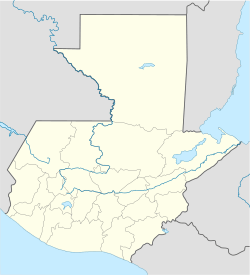San Pedro La Laguna facts for kids
Quick facts for kids
San Pedro La Laguna
Tz'unun Ya'
|
|
|---|---|
|
Municipality
|
|

View of San Pedro
|
|
| Country | |
| Department | |
| Municipality | San Pedro La Laguna |
| Government | |
| • Type | Municipal |
| Elevation | 1,610 m (5,282 ft) |
| Population
(Census 2002)
|
|
| • Total | 9,034 |
| • Ethnicities | Tz'utujil Ladino |
| • Religions | Roman Catholicism Evangelicalism Maya |
| Demonym(s) | Pedrano |
| Climate | Aw |
San Pedro La Laguna is a town in Guatemala. It is located on the southwest shore of Lake Atitlán. For many years, the Tz'utujil people have lived here.
Recently, San Pedro La Laguna has become a popular place for visitors. People come to learn Spanish at language schools. They also enjoy the nightlife and being close to the beautiful lake and volcanoes. One famous volcano nearby is Volcán San Pedro, which the town sits at the base of.
Local farmers grow crops like corn, beans, coffee, and avocado. Some women create beautiful belts, shawls, and skirts using a special weaving tool called a back strap loom. Many teachers from San Pedro work in the Lake Atitlán area. Tourists can enjoy activities like hiking the San Pedro volcano or the Mayan Face. They can also study Spanish, explore the restaurants by the lake, volunteer, and learn about local crafts.
Contents
Exploring San Pedro's Geography
San Pedro La Laguna is found on the southwestern shore of Lago de Atitlán. The town is located right under Volcan San Pedro. This volcano is very tall, reaching 9,905 feet (about 3,019 meters) above the lake. It is a popular spot for people who like climbing and hiking.
The town of San Pedro La Laguna sits on a flat area called a plateau. Roads go down from this plateau on both sides of a steep ridge to reach docks on the lake. The dock on the west side is called muelle municipal. Boats arrive here from and leave for the town of Panajachel. The east side has a dock named muelle santiago, which connects to Santiago Atitlan. The east side also has la playa (the beach). Here, people enjoy swimming, canoeing, and kayaking.
You can get to San Pedro La Laguna by boat across Lake Atitlán. Boats run regularly from Panajachel (about 45 minutes) and Santiago Atitlán (about 30 minutes). You can also take a direct bus from Guatemala City (about 4 hours), Xela (about 3 hours), and Mazatenango. The town is about an hour off the main Interamericana Highway (CA-1). Buses to San Pedro leave hourly from specific areas in Guatemala City and Xela.
Understanding San Pedro's People
San Pedro La Laguna is a small town with about 13,000 people. Most of the people living in San Pedro are Tz'utujil Maya. There is also a small, but growing, group of people from other countries, mainly Americans and Europeans. Over 90 percent of the population are indigenous people.
Beliefs and Religions
The main religion in San Pedro La Laguna is Roman Catholicism. This has been the most common religion since the 1500s, when the Spanish arrived in Guatemala.
Later, Protestant Evangelical churches from North America were allowed to come into communities. Because of this, more than 40% of the people in San Pedro are now Evangelical.
Even though Protestant and Catholic religions have been important for many years, about half of the people still follow traditional Maya rituals. They might practice these rituals on their own or along with another religion. Many locals believe that the world has both good and bad spirits. These spirits are thought to influence many parts of daily life.
For example, Xocomil is a wind that comes from the south. People say it "carries away sin." This wind usually visits the Lake Atitlán area around midday. If the wind comes from the north, the Maya believe the lake's spirit is taking away a person who has drowned.
In 2010, many Jewish visitors from Israel and North America started coming to San Pedro. Because of this, a synagogue (a Jewish place of worship) and a kosher restaurant opened. Today, you can see many Jewish tourists in San Pedro La Laguna. Many stores even have Hebrew signs. There are good relationships between the local people and the Jewish communities. Synagogue services happen every Saturday, including a Minyan (a group of ten adults needed for certain prayers) and Shabbat meals.
Local Traditions and History
The Museo Tz'unun 'Ya is a museum that shares the local history and traditions. It shows how the lake was formed and has old color photos of San Pedro La Laguna from before the Civil War. Traditional ways of healing are still common. Healers, known as curanderos, practice indigenous medical traditions.
A Look at San Pedro's Past
The Guatemalan Civil War lasted from 1960 to 1996. During this time, San Pedro La Laguna was mostly safe from the violence. However, from 1980 to 1982, there were some difficult events in the community. It was found that local military officials were involved in these actions. It was said that villagers were unfairly accused of not supporting the army or of helping rebels. Military officials would place rebel-like flyers and graffiti around the village at night to make these accusations seem true. This went on for almost two years until August 1982. At that time, higher military officials stepped in. After these local officials were removed, peace returned to the village.
Gallery
See also
 In Spanish: San Pedro La Laguna para niños
In Spanish: San Pedro La Laguna para niños






